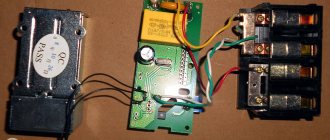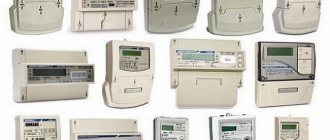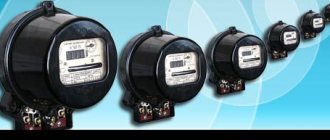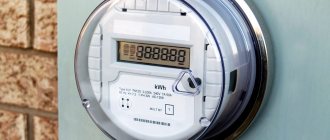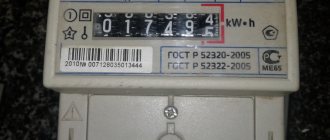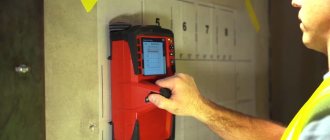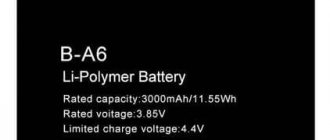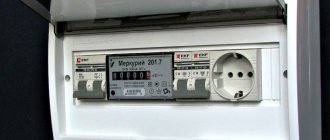Induction meter design
Single-phase induction meter
The main components of an induction electric meter are voltage and electric current electromagnets. When they interact together with the magnetic circuits included in them, an electromagnetic field appears. Through the transmission device, the field acts on the aluminum rotating disk.
The current electromagnet experiences heavy loads during operation, so its winding is made of large-section wire. The number of turns does not exceed thirty. The wire is evenly wound on two magnets, which are connected in series to the network using clamps.
The voltage coil is connected in parallel to the network and creates an electromagnetic field directly proportional to the effective voltage. The coil winding is made of thin wire with a cross section of 0.1…0.15 mm². The number of turns can reach 12,000, which makes it possible to create an inductive reactance greater than the active one. This device allows you to reduce energy consumption when the meter is operating.
All components of a mechanical single-phase electric meter are housed in a plastic housing. Data on electricity consumption for the current period are displayed on a digital drum. The intensity of energy consumption can be determined by the speed of rotation of the disk.
Is it possible to do something with an old electric meter?
Most Russian citizens either store broken and dismantled electric meters in garages, or throw them away with household waste in the nearest trash can. Both options are not correct.
There is no point in storing failed measuring instruments. They will only gather dust and take up space. But you shouldn’t throw them in the trash either. The fact is that electric meters contain heavy metals: mercury, lead and chromium. In the open air and under the influence of changes in the environment (humidity, temperature changes, etc.), the device quickly deforms, and the metals contained in it actively interact with chlorine and hydrocarbon compounds contained in the plastic housing of the meter. The entire process leads to the formation of highly toxic substances that can cause irreparable damage to the environment and humans in particular.
Therefore, it is best to hand over the old electric meter or dispose of it as indicated in the device data sheet.
Some citizens do not agree to quickly part with dismantled launchers and find other uses for them. For example, some craftsmen use an old, but working electric meter as a measuring device. That is, a socket is installed on one side, and a plug on the other. Connect the device and calculate its energy consumption. And also some craftsmen make money boxes, lanterns from old meters, or disassemble the device into parts and remove the magnet (induction PU).
How does an induction meter work?
The aluminum disk of an induction meter for electrical energy is a movable current-conducting element, which is affected by the electromagnetic field created in the meter's coils. As a result of their action, a magnetic field appears, variable in direction and acting on the disk, in which eddy currents are created that coincide in direction with the magnetic fluxes.
An interaction occurs between eddy currents and magnetic fluxes, which creates a torque that varies in magnitude and causes the aluminum disk to rotate. A relationship is created between the torque and the total magnetic flux from the two current and voltage coils, taking into account the 90º phase shift and feedback. To obtain the phase shift, the magnetic flux of the voltage electromagnet is divided into two parts.
Under the influence of torque, the disk rotates with a frequency depending on the amount of incoming energy. The axis of the disk is connected to the digital drum counting device, which reflects the actual amount of energy consumed.
Pros and cons of devices
The old-style disk electric meter has several advantages over new electronic meter models that are actively being introduced into residential buildings:
- have a high degree of reliability;
- simple design and principle of operation;
- the cost of an old-style electric meter is lower than an electronic one;
- indifferent to possible voltage drops in the electrical network;
- have a long service life.
At the same time, electromechanical meters also have a number of disadvantages, which include:
- Low accuracy class for electrical energy metering, especially at low loads.
- There is only one tariff used to pay for electricity, while most electric companies provide different prices for electricity during the day and at night.
- The ability to stop disk rotation, and even rewind the indicators, which can be taken advantage of by unscrupulous users. Stopping the disk is also possible in case of failure.
All the disadvantages inherent in induction products are known to the manufacturing plants. They are constantly working to modernize and improve the quality of their products, increasing the accuracy class and service life. However, the design features do not allow all these useful necessary conditions to be fully implemented in the device. Therefore, induction devices are being replaced by more advanced, electronic ones.
Where can I return my old electric meter?
Each measuring equipment, which includes electricity meters, has a technical passport. In it, the manufacturer must indicate the disposal procedure. In addition, you can find out which companies in your city accept old devices and under what conditions.
Recycle electricity meters
Due to the fact that improper disposal of electricity meters can cause significant harm to the environment, recycling should only be carried out by specialized companies. Such organizations must have equipment for safe disposal and permission from government agencies.
The process of recycling electric meters is based on the separation of the component components of the device: capacitors, LEDs and transmitting contacts. Considering that electric meters contain a highly toxic substance - metallic mercury, companies must carry out a demercurization procedure, that is, removing it using a physical and chemical method. Therefore, you should not be negligent in the process of recycling electricity meters.
Sell or throw away
As mentioned above, it is prohibited to throw meters into a landfill. Therefore, the logical question arises: what to do with an unnecessary device? It turns out that you can get a small benefit from recycling. If you throw away the device, you get nothing from it. But in the case when you hand it over for a recycling program to specialized companies, you can get a little money for it. The fact is that electric meters contain metals that are removed in laboratory conditions and using special equipment.
The question remains: where can I sell my old electric meter for money? To do this, you can contact your energy supply company. They often have special permission to carry out recycling and can accept old PU. Metrology companies, that is, those who verify electric meters, also provide similar services.
From the above, we can conclude that a faulty and dismantled electric meter can bring small financial benefits if it is not simply thrown away, but disposed of according to all the rules.
If you have already encountered the issue of disposing of an old electric meter, then we ask you to share your experience and leave a comment. Your experience is very important to us and other users, as it will help us learn more about our country's recycling program. We will also be grateful if you tell us about your option for using the dismantled metering device.
Do I need to replace the meters with new ones?
If you have an old induction meter installed, do not rush to replace it with a new one. It is quite possible that it will serve for a long time, until the end of the service life indicated in the passport, which is almost 20 years. However, in some cases they may be forced to make a replacement and you will be required to purchase a new meter.
Electricity meters must be replaced in the following cases:
- Work is underway to routinely update the electrical network with the replacement of all meters.
- The meter is faulty.
- The service life of the device has expired according to the technical data sheet.
By law, the user does not have to install an electronic meter when replacing. If it is convenient for him, he can install any induction electricity meter, the main thing is that the measurement accuracy complies with the requirements of the law: the accuracy class must be 2.0 and higher.
The cost of purchasing the meter and installing it is borne by the owner, unless a planned replacement is made. In some cases, ownership of the device requires clarification:
- When a meter is installed in an apartment, homeowners are required to monitor the technical condition of the device, take readings and replace it if necessary. All expenses are borne by the apartment residents.
- When an old-style electric meter is installed in a common corridor and several apartments use it, the device is the common property of all owners. The costs of replacing it will be borne by all parties. If this is provided for in the contract with the service company, the company itself changes the meter using the collected funds.
- When the meter is the property of an energy company licensed to carry out such work, replacement is carried out at its expense.
If there are no compelling reasons to change the electricity meter, the requirements of the inspection bodies for replacement are not legal. In this case, the metering device must be in good working order and not expired.
Why do you need to change your electric meter?
In any residential premises there is a measuring device installed that calculates electricity consumption. Like any high-precision equipment, electricity meters must be periodically verified. On it, using standards, the error in the readings given by the meter is revealed. If they exceed the standard, the device must be disposed of.
Reference! Induction electricity meters and devices with a class higher than 2.0 are not accepted for verification and must be replaced, since their accuracy class is very low. For modern devices it varies in the range from 0.5 to 2.0 .
It is necessary to replace old metering devices (MU) with new ones in the following cases:
- the service life of the old-style meter has expired;
- the device is broken or has incorrect settings;
- scheduled work on electrical networks, involving replacement of the control unit.
Apartment owners have a question: what to do when replacing an electric meter and where to put the old one? Installation work is carried out by electricians of an energy sales company, for example, Mosenergosbyt. This is due to the fact that the meters are sealed and only a specialized company has the right to remove or install the seal. The electrician takes readings from the old meter and then installs a new electric meter.
In this case, the old PU remains with the owner of the apartment. Experts recommend storing it for about 2-3 months, in case there are discrepancies in the transmitted readings with the accounting department of the energy sales company. After this, the electricity meter must be disposed of.
Tariff accounting system
The most significant drawback is the inability to use several tariffs to pay for electricity. Therefore, the need to replace the old electric meter with a new one depends on how energy consumption changes during the day. If there is significant consumption at night, it makes sense to switch to a more modern electronic meter. However, you should take into account the costs of purchasing and installing a new electronic meter.
Meter connection diagrams
To bookmarks
General rules for connecting meters
The first thing you need to do before connecting the meter is to study its passport, in particular the manufacturer’s requirements for the installation location, mounting method and operating conditions of the electric meter (for example, induction meters are designed for operation at temperatures from -10 to + 40 °C and therefore cannot be installed in unheated rooms without equipping them with a heating device in winter; electronic meters, as a rule, have a larger operating temperature range and can be installed in unheated rooms without installing devices for heating them).
In addition, it is necessary to take into account the requirements of current regulatory documents regulating the requirements for connecting electricity meters:
- For each house/apartment, only one single-phase or three-phase electric meter should be installed (clause 7.1.59. PUE) with the exception of cases of connecting electrical installations of different tariff groups (for example, installing high-power electric heating units)
- To safely replace a meter directly connected to the network, a switching device must be provided in front of each meter to remove voltage from all phases connected to the meter. In this case, disconnecting devices for removing voltage from settlement meters located in apartments must be located outside the apartment. (clause 7.1.64. PUE)
- After the meter connected directly to the network, a protection device must be installed. If several lines equipped with protection devices extend after the meter, installation of a common protection device is not required. (clause 7.1.65. PUE)
Single-phase meter connection diagram
Single-phase meters are the most common electrical energy metering devices; they are used to meter electricity at loads, usually up to 12 kW (up to 60 Amperes) in residential buildings/apartments, small businesses (trade pavilions, stalls), etc.
Connecting a single-phase meter does not require deep knowledge of electrical engineering as it has a simple connection diagram. All single-phase meters, both electronic and induction, have only four terminals for connection:
Contact 1 - for connecting the phase supply wire; Contact 2 - for connecting the phase wire going to the electrical receivers; Contact 3 - for connecting the neutral supply wire; Contact 4 - for connecting the neutral wire going to the electrical receivers. Thus, the input power cable is connected 1 and 3 2 and 4 . That is, connecting the wires to the meter looks like this:
Taking into account all the requirements stated above, the connection diagram for a single-phase electricity meter should have the following form (since the connection diagram for an induction electric meter is identical to an electronic one, we present one general diagram with an electronic meter):
- Two-pole circuit breaker - for the ability to remove voltage from the meter for its safe replacement
- Single-pole circuit breakers - to protect the electrical network from short circuits and overloads
- RCD - for protection against electric shock and fire.\
Three-phase meter connection diagram
Three-phase meters are used to meter electricity, as a rule, at facilities with a connected power of more than 12 kW (more than 60 Amperes), as well as in the presence of three-phase electrical equipment, regardless of power.
Connecting a three-phase meter is similar to a single-phase one, the only difference is in the number of connected phases. Three-phase meters have 8 terminals for connection:
Contact 1 - phase 1 input from input; Contact 2 - output of phase 1 to the load; Contact 3 - phase 2 input from input; Contact 4 - output of phase 2 to the load; Contact 5 - phase 3 input from input; Contact 6 - output of phase 3 to the load; Pin 7 - zero input from input; Contact 8 - zero output to the load.
Thus, connecting the wires to a three-phase meter will look like this:
However, it should be noted here that connecting the old meter has some features, namely, three-phase five-amp induction meters, which were previously used as direct-connection meters, have not 8 terminals for connection, but 11 for the possibility of connecting them through measuring transformers:
Direct connection of such a meter to the circuit is carried out as follows:
Contact 1 - phase 1 input from input; Pin 2 - jumper from pin 1; Contact 3 - output of phase 1 to the load; Contact 4 - phase 2 input from input; Pin 5 - jumper from pin 4; Contact 6 - phase 2 output to load; Contact 7 - phase 3 input from input; Pin 8 - jumper from pin 7; Contact 9 - phase 3 output to load; Pin 10 - zero input from input; Contact 11 - zero output to the load.
Since such meters are still found, we also present their connection diagram:
Taking into account all the above requirements, the connection diagram for a three-phase meter will look like this:
- Three-pole circuit breaker - for the ability to remove voltage from the meter for its safe replacement
- Three-pole circuit breaker - to protect three-phase electrical equipment from short circuits and overloads
- Single-pole circuit breakers - to protect single-phase electrical equipment from short circuits and overloads
- RCD - for protection against electric shock and fire.
Was this article useful to you? Or maybe you still have questions ? Write in the comments!
Didn’t find an article on the website on a topic that interests you regarding electrical engineering? Write to us here. We will definitely answer you.
↑ Up
5
https://elektroshkola.ru/uchet-elektroenergii/sxemy-podklyucheniya-schetchikov/
Taking readings
Electromechanical meters are equipped with a digital drum that displays electricity consumption in kilowatts. You can submit this data to the settlement service or make calculations yourself.
Depending on the model, 5 or 7 numbers appear on the reel display, with the last one separated from the rest by a comma and highlighted in color. When accounting, you do not need to count tenths and hundredths of kilowatts - only whole numbers. The resulting kilowatt consumption per month is multiplied by the cost of 1 kilowatt and the amount that must be paid for electricity is obtained.
